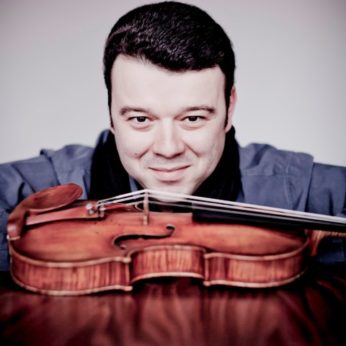Composer: Ludwig van Beethoven (b. 1770 - d. 1827)
Performance date: 27/06/2010
Venue: St. Brendan’s Church
Composition Year: 1800-01
Duration: 00:22:50
Recording Engineer: Anton Timoney, RTÉ lyric fm
Instrumentation: vn, pf
Instrumentation Category:Duo
Artists:
Vadim Gluzman -
[violin]
Angela Yoffe -
[piano]

This Sonata was written as a companion
to the A minor Sonata Op.23 and originally they were published
together as a single opus. They were both dedicated to Count Moritz
von Fries, a wealthy banker, who regularly hosted musical soirées
and was a dedicated supporter of Beethoven. The two sonatas were the
culmination of a busy year for Beethoven that began with the
completion of his First Symphony and its first not very successful
performance that April. This took place in a concert that began with
a Mozart symphony, excerpts from Haydn’s Creation, a piano
improvisation by Beethoven, followed by his Septet, First Symphony
and probably his First Piano Concerto, well over three hours music.
By all accounts the musicians did not last the course. His next
composition was the Horn Sonata, reputedly written in one day, and
the early summer was taken up with the completion of the Op.18
quartets, which involved rewriting the first two. Finally he tackled
two solo piano works and the two violin sonatas. So this eventful
year ended with publishers competing for his works, patrons competing
for his performances while the composer struggled with the
life-threatening shadow of his deafness.
The nickname Spring did not come
from Beethoven, but it is not inappropriate for this fresh and
melodious work. The opening melody is striking in its originality and
gracefulness. The mixture of long and short notes makes the line
totally unpredictable while the main theme is for the first time in
the series of violin sonatas actually introduced by the violin.
Contrast with this shapely melody is given by the echoing second
subject, which, unusually, provides the material for debate in the
development.
This is probably the best loved of
Beethoven’s sonatas on account of its irresistible lyrical invention,
but it is the slow movement in particular that resonates most deeply
with audiences and players alike. The quiet beauty of the theme is
instantly and eloquently seductive. There is no passion, rather a
gentle radiance and a hushed joyfulness, whose climactic moment is
the pianissimo coda.
The miniature Scherzo – it lasts just
over a minute – is the first one in his violin sonatas. It is
rhythmically ingenious and frames a tiny but vociferous trio. The
rondo finale follows without a break and is a masterpiece of
spontaneity and carefree lyricism, while the intervening episodes
provide the necessary backbone.
Copyright © 2024 West Cork Music. All rights reserved.
Designed and developed by Matrix Internet